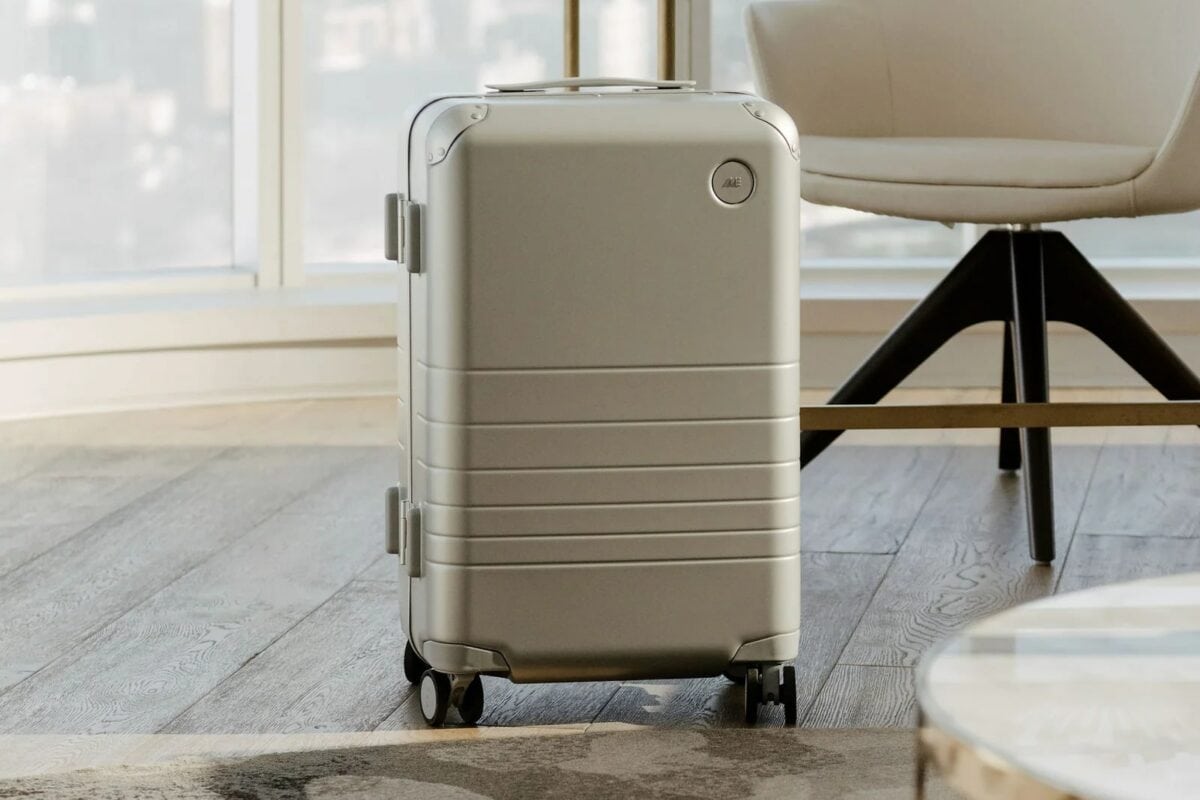Having the right approach, the right supplies, and a healthy amount of patience goes a long way toward making your grimy suitcase look like new.
How To Clean a Suitcase: Tips to Make Your Luggage Look Like New
So you got back from a trip and your suitcase is covered in dirt, smells funny, and has black grease stains all over (where did those come from!?).
If you’re like me, the first thing you probably did is search on Google for some tips to clean your luggage (and that’s how you ended up here)! Well, luckily for you, I’ve tested a myriad of techniques for cleaning luggage. There is a lot of great information online, but there are also some misleading tips.
Want to know what really works? Read on, my cleanly traveler.
Cleaning luggage usually involves more than just wiping it down with disinfecting wipes. Cleaning the inside and outside are different, and the cleaning process is different for hard vs soft luggage. Plus, you may have stubborn stains that you need to get out.
No matter what kind of luggage you have, or what part of your suitcase you’re aiming to clean, I’ll walk you through a step-by-step process to get your luggage looking like new again.
Now, let’s get cleaning!
What You’ll Need to Clean a Suitcase
Before you get started, there are a few simple supplies you’ll need to make sure you get your suitcase as clean as possible. Fortunately, these are all common household items that you probably already have lying around.
- Rag or microfiber cloth
- Old toothbrush or soft bristle brush
- Warm water
- Concentrated vinegar
- Dish soap (or other gentle soap)
- Liquid laundry detergent
- Baking soda
- Vacuum
- Toothpaste, eraser, or auto trim restorer (for removing scratches in hardside luggage)
These are the main items I’ve found work best for cleaning luggage, but you don’t need all of them for every piece of luggage. For example, baking soda is only needed for getting black grease stains out of soft-sided luggage, and dish soap is only needed for hard-shell luggage.
What to Use as a Luggage Cleaner
It seems there are special chemicals for cleaning every individual item you own. There are bathroom cleaners, kitchen cleaners, laundry detergents, dish soaps, window cleaners, stain removers, and more.
So what do you use for luggage?
Fortunately, there are a lot of options out there, and most of them use stuff you already have in your home. I’ve already listed the main ingredients you’ll need in the last section, but here are some of the best solutions I’ve found for luggage cleaners:
- Water + Laundry Detergent: A 5 to 1 mixture of warm water to laundry detergent works great for softside luggage. This mild solution soaks into fabric bags and is easy to clean off.
- Water + Dish Soap: For hardside luggage, a dish soap and water mixture does the trick perfectly and works well to clean off any smudges or dirt on the shell. You don’t need to go too heavy on the soap, either, just enough to get some bubbles.
- Water + Vinegar: If your suitcase has stubborn stains or nasty smells, a 3 to 1 mixture of vinegar and clean water can work wonders. Just know your suitcase will smell like vinegar for a few days.
- Baking Soda: If you find black grease stains on your suitcase, baking soda works really well for soaking up any residue in the fibers. I like to alternate between using baking soda and soap and water to remove stubborn stains.
- Upholstery Shampoo: If you want to go really deep, a foaming upholstery cleaner will provide the most thorough clean for softside luggage. It’s a bit harder to use and requires you to have a wet/dry vacuum to suck up the foam, so I think it isn’t really necessary.
How To Clean Inside of Luggage
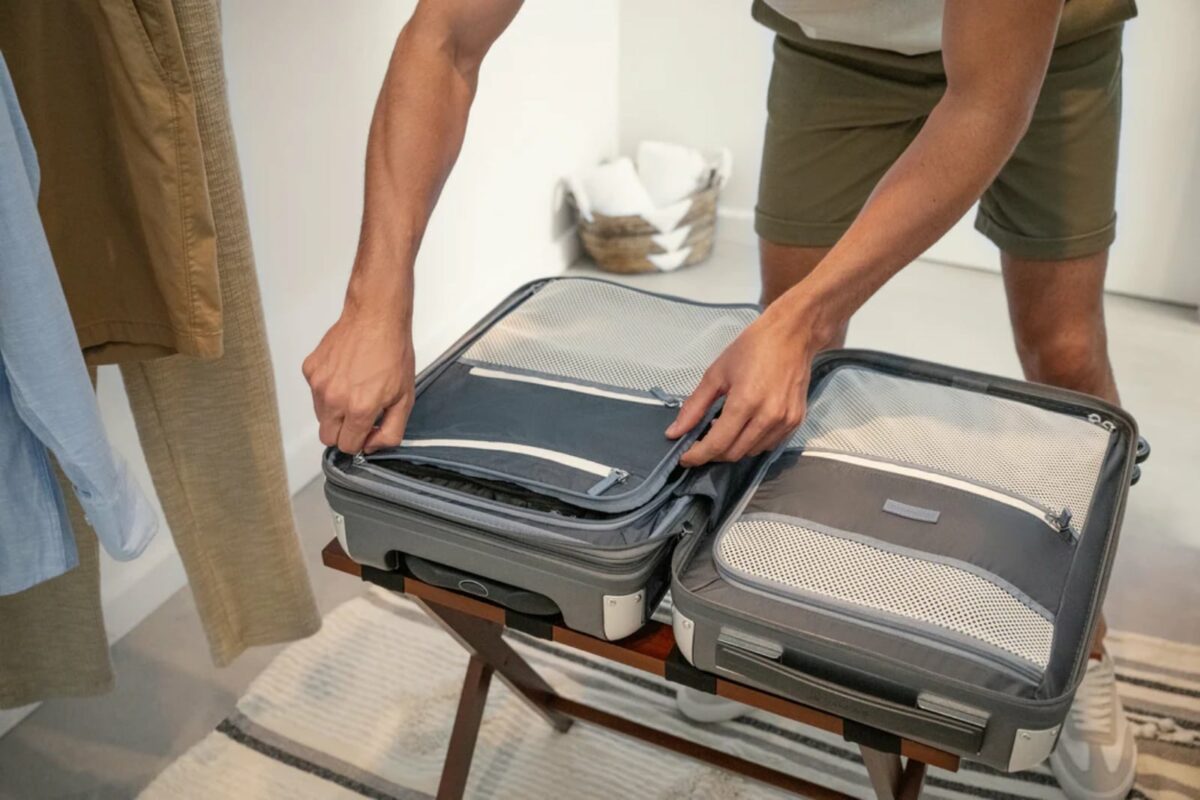
Regardless of whether you have a hard or soft suitcase, it probably has a lightweight synthetic fabric lining inside (usually made of polyester). The lining of higher-quality luggage will usually have a stain-resistant treatment, but it still can collect dirt, stains, and funky odors over time.
If you’re lucky, your suitcase may come with a removable lining. If that’s the case, just unzip it, throw it in the wash (stick to cool, delicate cycles), and you’re done (Yay!). For everyone else, there are a few more steps to clean your luggage’s interior lining:
Step 1: Vacuum
Yep, break out your trusty vacuum and vacuum out the inside of your case. The purpose of this is just to get out any loose dirt, dust, or Dorito crumbs that may be left in there.
If you’re feeling lazy, you can also just turn your suitcase over and shake it out to get rid of anything hanging out inside. A vacuum just works better for sucking out dust that may cling to the lining.
Step 2: Wipe With a Damp Cloth
To start, you don’t necessarily need to break out any chemicals. Just use a wet rag or microfiber cloth to wipe out the lining. Pay close attention to the corners and places where the lining is folded over itself.
Most of the time this is all you’ll need to do. It will clean out dirt and grime, and then you’ll be on your way. However, if there are still stains and marks on the fabric, it’s time to break out some chemicals in the next step.
Step 3: Clean With Detergent
Start by making a roughly 5-to-1 mix of water-to-laundry-detergent. It doesn’t need to be super precise. I will typically just pour about a half-inch of detergent into a cup and fill the rest with water and mix it. Somewhat warm water also works better.
Use a rag or a soft brush to scrub this detergent/water mixture all over the lining. More scrubbing = more clean. If there are any obvious stains, spend a bit more time scrubbing there (and put some elbow grease into it).
After you’ve got it all lathered up, let it sit for a few minutes, then wipe it out with a damp cloth.
Step 4: Air Dry
After you’ve finished cleaning out the inside of your suitcase, you’ll want to leave it open to dry. Ideally, you could set it outside in sunlight somewhere, but laying it out in your living room works too. Depending on how much you soaked it this could take half an hour to half a day.
Once you’re done cleaning the inside, it’s time to clean the suitcase exterior.
How To Clean Soft-Sided Luggage
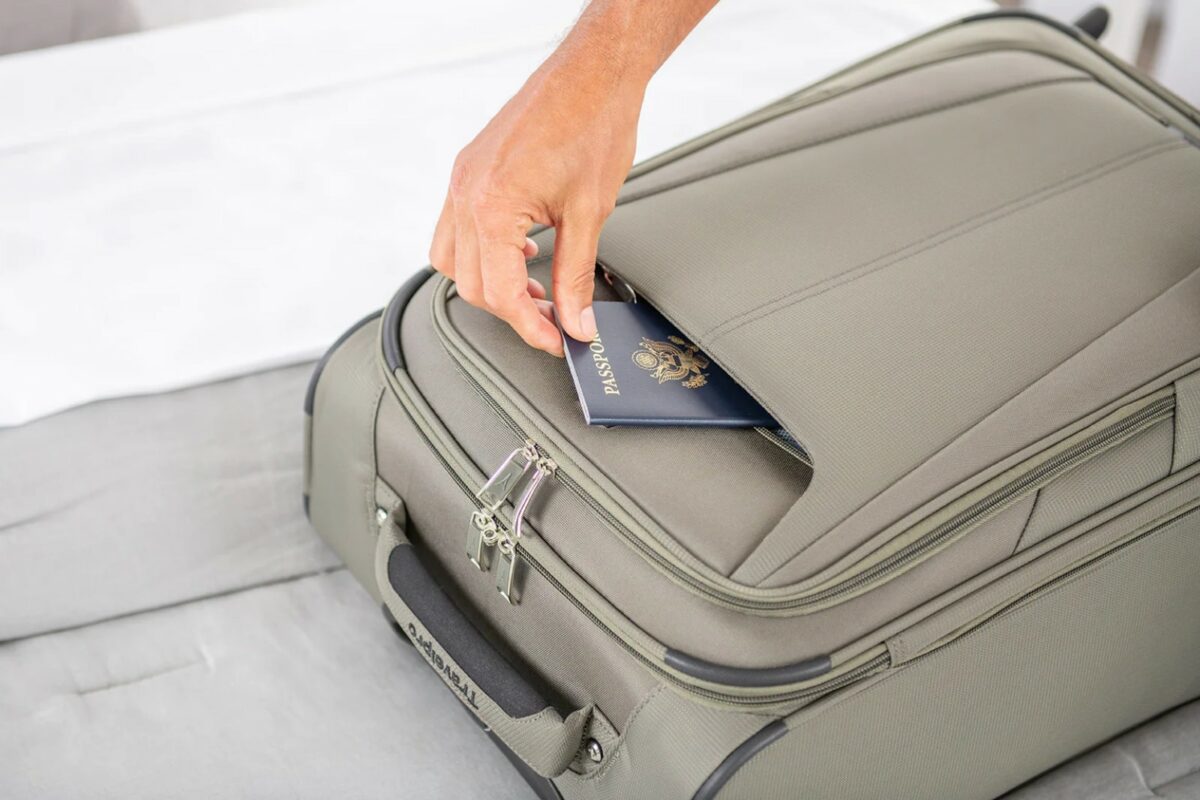
Soft-sided luggage is typically more resistant to visible damage than hard-shell luggage, but it also gets dirty easier and is harder to clean. The process is fairly similar to cleaning the interior lining, but typically takes a bit more time and effort since the outer fabric is thicker.
Depending on how dirty your suitcase is (and how energetic you’re feeling), you may not need to do all of the steps below. Think of this as a full deep clean process, and just do what you need to get your luggage clean enough.
Step 1: Spot Clean With Water and Vinegar
Mix 1 part vinegar with 3 parts water in a spray bottle (you can also use rubbing alcohol or hydrogen peroxide instead of vinegar). Spray the solution over dirty areas and use a damp cloth to wipe it off. Vinegar is great at getting stains, dirt, and weird smells out, but your suitcase may smell like vinegar for a few days.
Step 2: Full Scrub With Detergent
If you want to go for a deeper clean, mix laundry detergent with warm water and use a bristle brush to work it into the outer fabric of the suitcase. Keep scrubbing until you get a good lather on the fabric, and then wait.
After letting it sit for 10-15 minutes, use a damp or dry cloth to wipe away any excess bubbles or water from the surface. You can repeat this step multiple times if your suitcase is really dirty. The more you scrub, the cleaner it will get, so put some muscle into it!
Step 3 (Optional): Remove Grease Stains with Baking Soda and Stain Remover
If there are still some stubborn stains you haven’t been able to get out, it’s time to break out some chemistry magic.
You’ll start by pouring a little bit of dry baking soda over the stain. Use an old toothbrush to rub it into the fibers as deep as you can. Let it sit for at least 30 minutes (longer is better).
Then, use a laundry stain remover like OxiClean mixed with warm water (follow the directions on the package). Use a damp cloth to work the solution into the fibers and then wipe it clean.
You may have to repeat this process a few times, going back and forth between baking soda and another cleaner, to fully remove a stain. Persistence is key!
Step 4: Air Dry
After everything, leave your suitcase out to dry with all the zippers open. Make sure the suitcase is totally dry before putting it away, or you may risk developing mildew (just leave it out a bit longer than you think necessary).
How To Clean Hard-Sided Luggage
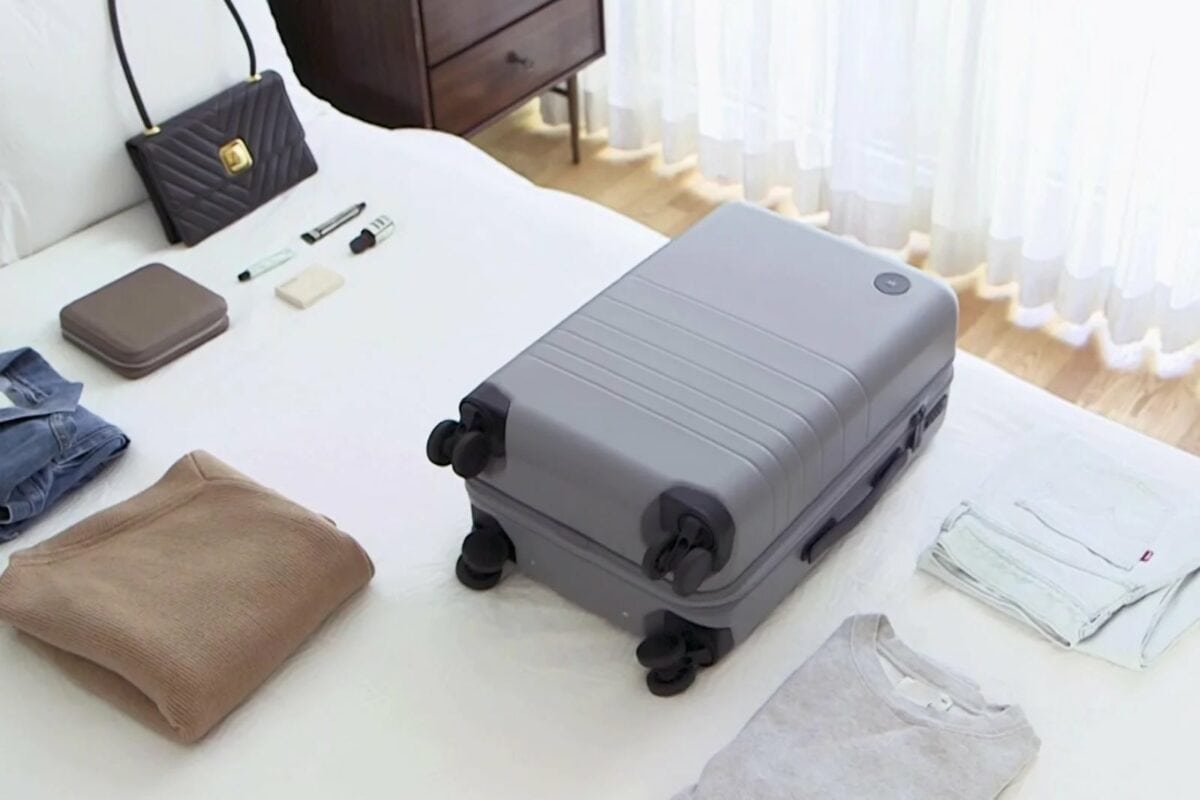
Hard-sided luggage is much easier to clean than soft fabric luggage because it won’t absorb any stains, dust, or odors. It can be as simple as using a soft cloth or disinfecting wipe to wipe down the outer shell and remove any dirt.
If you want to clean it a bit more thoroughly (for example: if there are still marks on the case), dish soap is a great way to clean the hard plastic. Mix some dish soap into a bowl of warm water, and then use a soft cloth to scrub down the outside with this soap and water mixture. With a bit of work (and maybe a bit more soap), you should be able to clean hard shell luggage from any marks with no problem.
While hardside luggage is typically easier to clean, it does tend to show scratches and scuff marks more than soft-sided luggage. Read on to learn some tips for removing scuff marks.
How to Clean Leather Luggage
Leather is a beautiful natural material that is durable and great-looking, but it does require a bit of extra care. If you really take care of leather luggage, it can easily last for decades. If not, you may find yourself with a cracked, dried-out leather suitcase that’s ripping at the seams.
Fortunately, it isn’t too hard to keep your leather suitcase in top condition. Just follow these steps to clean and preserve it periodically, and it’ll be around to pass down to your kids.
Step 1: Brush Off With a Dry Cloth
Leather suitcases don’t do well with lots of water, so I recommend using a soft cloth that is either totally dry or very slightly damp to brush off any dirt or dust on your suitcase.
The goal here isn’t to get it totally clean yet. Just focus on removing obvious dirt.
Step 2: Clean With a Special Leather Cleaner
A leather suitcase is definitely one place where you don’t want to just use a soap and water mixture to clean. Too much soapy water can lead to warping, discoloration, and even cracking. You also don’t want to use any other cleaning chemicals because they can strip leather of it’s natural oils.
Instead, use a dedicated leather cleaner that will clean your suitcase without drying it out. Spray it evenly over your suitcase and then wipe it clean with a microfiber cloth. Unlike water, a leather-specific cleaner will be designed to refresh and renew your suitcase with a special formula that will help preserve the leather.
Step 3: Treat With Leather Conditioner
If you really want to do your best to preserve your leather luggage for years to come, follow up cleaning with a leather conditioner spray. This will restore the natural color and softness and help repel moisture.
Important note: suede leather needs different products than regular leather. If you have a suede suitcase, make sure you use a specific suede cleaner and conditioner. I don’t know what’s different about it, but just get the right one for your suitcase.
How to Remove Scuff Marks and Scratches from Luggage
Hard shell luggage can start to show some wear and tear and look pretty beat up over time. Fortunately, there are some easy ways to remove or hide scratches.
If you really want to keep your suitcase looking good, a luggage cover can be a good way to prevent scratches in the first place. A luggage cover is designed to wrap around your suitcase and protect the hard shell from impacts and scratching.
Here are a few different methods you can use (hint: these will also work for scratches on plastic components of softside luggage):
Method 1: Rubber Eraser
If your hard suitcase is covered in small scratches and scuff marks, simply rubbing those areas with a rubber eraser can make them vanish. This sounds crazy, but it works amazingly well for small marks.
Bigger scratches will still be there, but this goes a long way toward making your suitcase look like it hasn’t been thrown off a mountain.
Method 2: Toothpaste and Toothbrush
Here’s an easy way to remove some of those deeper scratches in your hard shell suitcase: Spread a little bit of regular toothpaste over the scratch. Then get to work rubbing it in with a toothbrush. You can’t really overdo it, so go full hog with the scrubbing.
Toothpaste has thousands of tiny particles that act like a polishing abrasive when you scrub them into the material, so they will buff out scratches. You probably won’t be able to full eliminate every single scratch, but you can make it so they aren’t visible unless you’re looking closely.
Method 3: Automotive Trim Restorer
This last method works really well on handles, corner bumpers, and other plastic components, but you can also use it on hard shell suitcases.
An automotive trim restorer is a product that’s designed to refresh, seal, and protect plastic pieces in cars, and it also works really well for luggage. Essentially, it’s a liquid that you wipe over any plastic surface with a dry cloth or sponge.
Hint: try it out on a small inconspicuous area (like the bottom) first to see how it looks, because it is possible that it will change the shine or color of your luggage slightly.
How To Clean Luggage With Bed Bugs
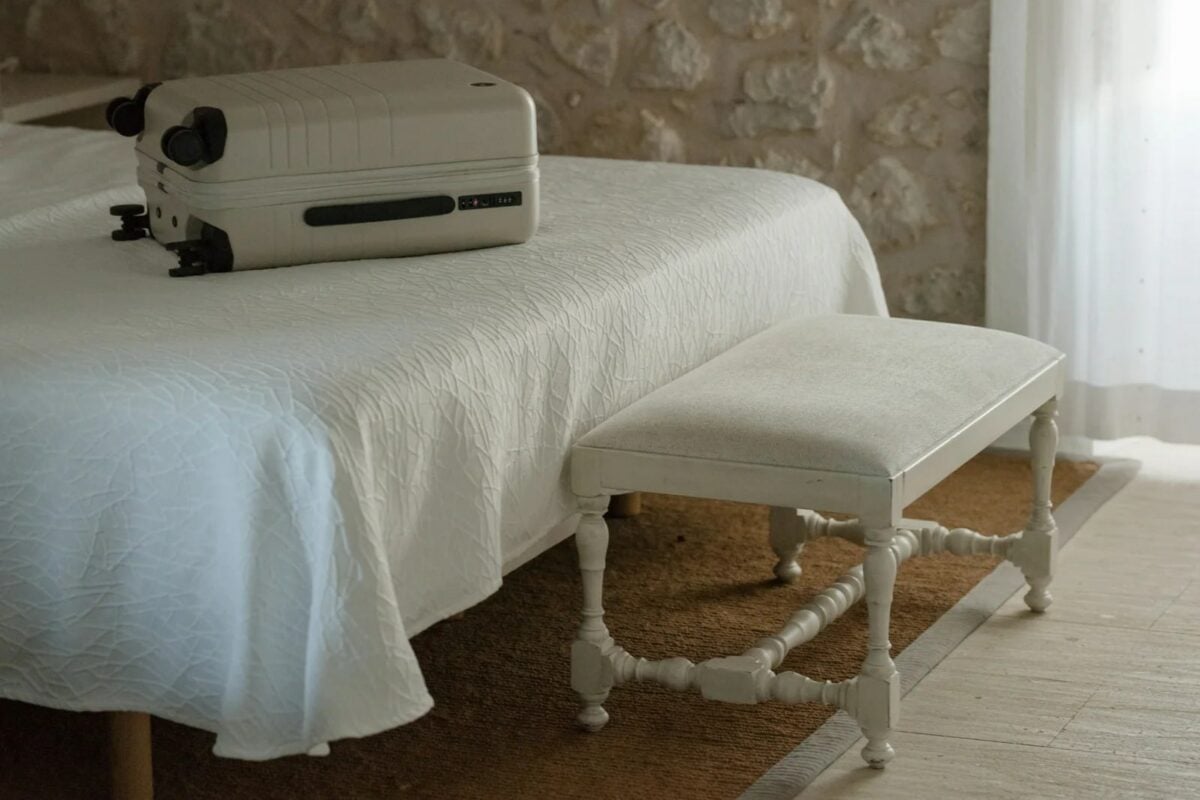
Bed bugs are the worst. Period.
If you’ve never had the experience of dealing with these nasty insects, thank your lucky stars for it. It is not fun. They can hitch a ride home in your clothes or travel gear and quickly spread throughout your home. Waking up to the red rashes caused by their bites is not a great end to a trip.
Unfortunately, if you travel to less developed countries (including regions in South Asia, Africa, and South America), there’s definitely a risk of getting bugs in your clothes and then in your luggage. Many places in the US are even known for having them (mainly the South).
If you find out your suitcase has been infested, here is the cleaning process to ensure it gets totally disinfected:
Step 1: Keep Everything Isolated
The first thing to do is unpack everything straight into big black trash bags right away and tie them off so the bugs can’t get out. Do the same thing with your suitcase.
The last thing you want is for the bugs to get out and infest your carpet, mattress, and furniture. Trust me, EVERYTHING goes into garbage bags.
Step 2: Heat Kills Bugs
Bed bug colonies will die after 20 minutes in any temperature over 118-degrees, though their eggs only die after 90 minutes. So, your goal should be to get your suitcase (and everything else) to over 118 degrees for at least 90 minutes.
For clothing, you can do this by putting it all in a dryer on high heat.
It’s a little harder for a big bulky item like a suitcase though. Fortunately, if it’s summer and you live in a warm climate, there’s a pretty easy solution. Take your suitcase outside (still in its black garbage bag) and leave it out in the direct sunlight. All day.
The black bag will absorb sunlight and heat up, so as long as the outdoor temperatures get above 90, you can be pretty confident that it got hot enough inside to kill everything.
Another option is to put the black bag in a car parked in full sunlight.
If the weather isn’t warm enough to use sun heat to kill the bugs, it’s probably best to take your suitcase to a professional dry cleaner to have it fully disinfected.
Step 3: Deep Clean
After you’ve killed all the bugs with heat, you’ll want to do a full clean of your suitcase using the steps I’ve outlined in the other sections. Your suitcase should be free of live bugs now, so the goal is just to get it as clean as possible.
How To Clean Luggage FAQs
-
How do you clean fabric luggage?
The best way to clean fabric luggage is to mix water and detergent and scrub the fabric thoroughly.
-
Can you dry clean the inside of a suitcase?
Yes, you can take a suitcase to a dry cleaner to have it professionally cleaned inside and out.
-
Should you clean your luggage?
Cleaning your luggage regularly can eliminate odors, make it look better, and even extend its life.
-
Why does my suitcase smell bad?
A bad smell from your suitcase usually comes from mold/mildew. Fortunately, it’s easy to clean out.
-
How do you deodorize an old suitcase?
Use 1 part vinegar to 3 parts water. Spray the suitcase inside and out and wipe out with a cloth.
